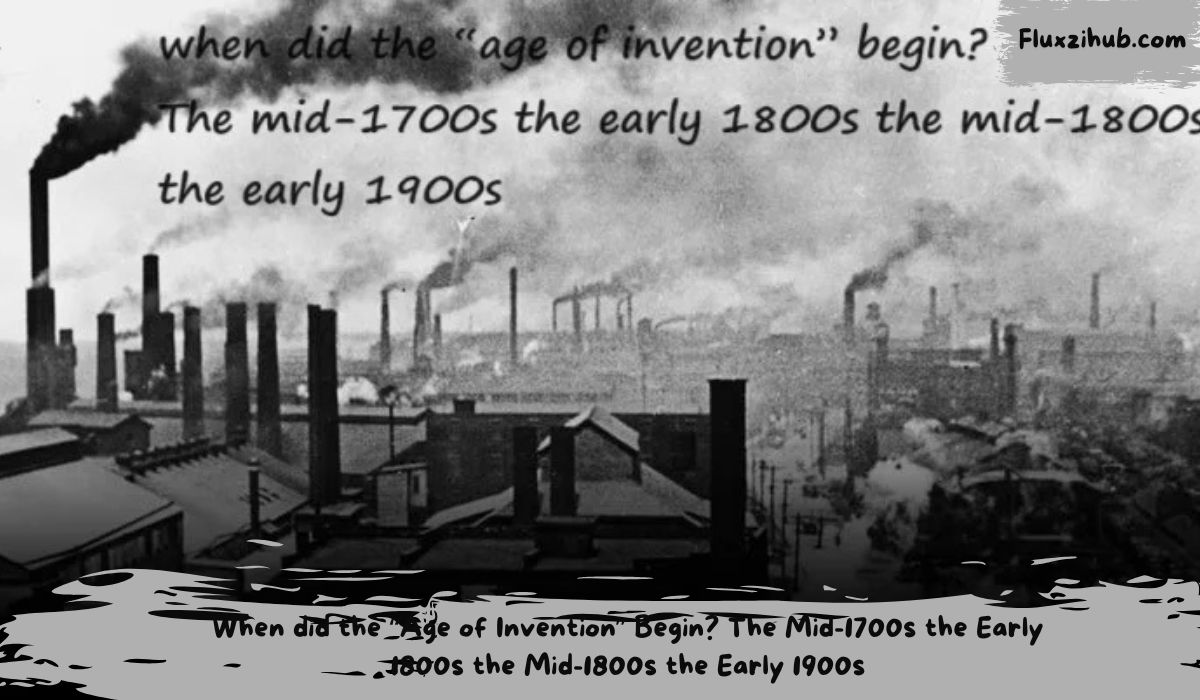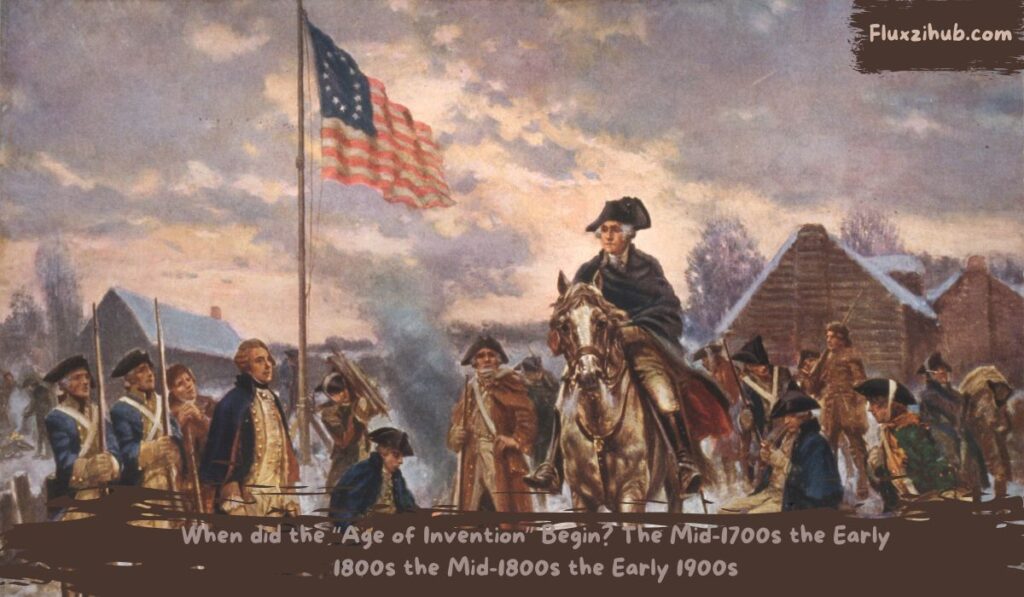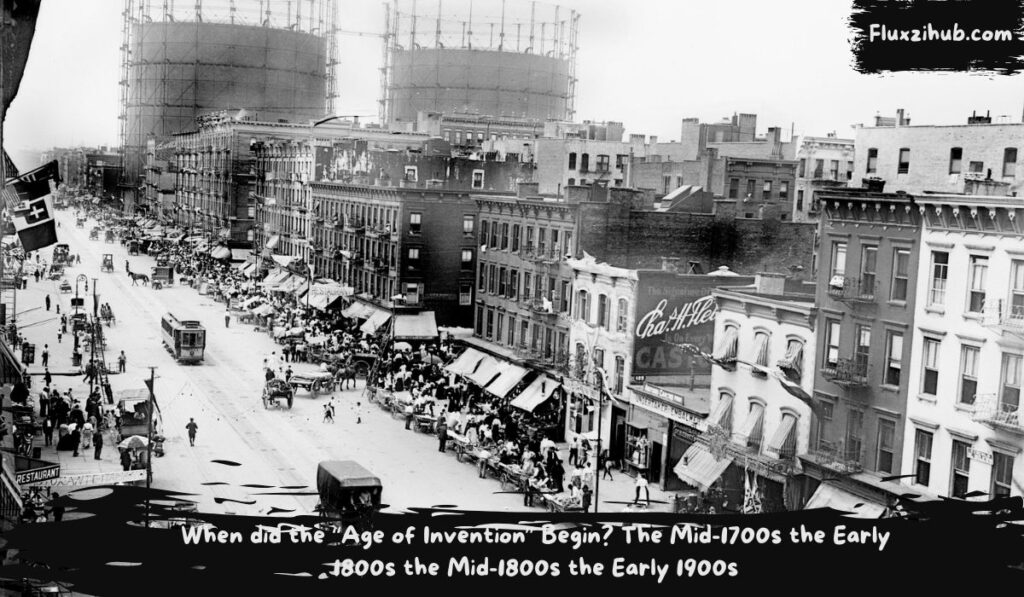
The Age of Invention marks a period in history characterized by rapid technological progress, significant inventions, and transformative changes in society. This era witnessed innovations that altered industries, transportation, communication, and daily life. However, pinpointing when did the “age of invention” begin? the mid-1700s the early 1800s the mid-1800s the early 1900s. The start of this era is generally associated with various periods, including the mid-1700s, early 1800s, mid-1800s, and early 1900s.
When Did the “Age of Invention” Begin?
The Age of Invention is often linked to significant milestones in technology and industry. To identify when it truly began, let’s examine each of these eras and their impact.
| Time Period | Key Innovations | Description |
|---|---|---|
| Mid-1700s | Industrial Revolution, Steam Engine | Marked the early stages of industrialization. |
| Early 1800s | Telegraph, Steam Locomotive | Communication and transportation improvements. |
| Mid-1800s | Electricity, Sewing Machine, Telephone | Advanced manufacturing and communication technologies. |
| Early 1900s | Automobiles, Airplanes, Radio | Introduced modern transportation and mass media innovations. |
Mid-1700s: The Industrial Revolution Begins

The mid-1700s is often considered the dawn of the inventions period, as it aligns with the onset of the Industrial Revolution. During this period, groundbreaking inventions such as James Watt’s steam engine (1775) revolutionized industries like textiles and manufacturing. Factories began to rely on mechanized systems, moving away from manual labor.
Key Innovations of the Mid-1700s:
- Steam Engine: Pivotal in powering factories and later transportation systems.
- Spinning Jenny (1764): An early invention in textile manufacturing that paved the way for mass production.
While the mid-1700s marks the beginning of industrial mechanization, some historians argue that the true “Invention age” began in subsequent decades, when communication and transportation advancements truly transformed society.
Read Also: Gardenedgingexpert.com/blog: Expert Tips and DIY Ideas
Early 1800s: Communication and Transportation Take Off

The early 1800s saw major advancements in communication and transportation. The invention of the telegraph in 1837 by Samuel Morse changed how people communicated over long distances.
How Did People Use a Telegraph to Communicate Without Speech?
Telegraphs used Morse code, a series of dots and dashes representing letters, to send messages across vast distances. By interpreting the patterns, people could communicate without speaking, which was a revolutionary change at the time.
Another critical development was the introduction of the steam locomotive, which transformed both local and long-distance travel, making it faster and more efficient.
Key Innovations of the Early 1800s:
- Telegraph (1837): Enabled communication over long distances.
- Steam Locomotive (1804): Revolutionized transportation and laid the foundation for rail networks.
Mid-1800s: The Advent of Electricity
According to when did the “age of invention” begin? The mid-1700s the early 1800s the mid-1800s the early 1900s. By the mid-1800s, the invention age had fully matured, with electricity playing a central role. Thomas Edison’s invention of the light bulb (1879) and Alexander Graham Bell’s telephone (1876) are just two examples of how this era transformed daily life.
How Did the Completion of the Transcontinental Railroad Affect Society?
The Transcontinental Railroad (completed in 1869) revolutionized the way goods and people moved across the United States. By connecting the eastern and western U.S., it:
- Accelerated Trade: Goods could be transported faster and more efficiently across the country.
- Urbanization: It promoted the growth of cities as hubs of commerce and transportation.
- Cultural Exchange: It allowed for the faster movement of ideas, leading to a more interconnected society.
Key Innovations of the Mid-1800s:
- Telephone (1876): Revolutionized personal and business communication.
- Light Bulb (1879): Extended productivity by illuminating homes and factories.
- Transcontinental Railroad (1869): Connected major regions, fostering economic growth.
Read Also: Wordiply Today: Success with Expert Tips & Common Pitfalls to Avoid
Early 1900s: The Modern World Emerges

In early 1900s solidified the transition into modernity. Henry Ford’s assembly line in 1913 made automobiles accessible to the masses, and the Wright Brothers’ first powered flight (1903) revolutionized global transportation.
Key Innovations of the Early 1900s:
- Automobile (Model T, 1908): Revolutionized personal transportation.
- Airplane (1903): Opened new possibilities for global travel.
- Radio (1906): Brought mass communication to a new level, enabling instant broadcasting of news and entertainment.
The Impact of the Age of Invention on Urbanization
How Urbanization Was Transformed by Inventions
As people consider when did the “age of invention” begin? the mid-1700s the early 1800s the mid-1800s the early 1900s—they note that this era saw many technological advancements that directly contributed to the growth of cities. As industries grew, people moved from rural areas to cities in search of jobs in factories, thus fueling urbanization. The following statements best describe how urban growth was impacted:
- Industrial Jobs: The creation of factories led to a demand for labor.
- Transportation: The invention of railroads and streetcars made it easier for people to move into urban centers.
- Utilities: Electricity and public services made city life more attractive.
Major Inventions Across Key Eras
| Era | Major Invention | Inventor | Impact |
|---|---|---|---|
| Mid-1700s | Steam Engine | James Watt | Powered factories and trains. |
| Early 1800s | Telegraph | Samuel Morse | Revolutionized communication. |
| Mid-1800s | Telephone | Alexander Graham Bell | Changed global communication. |
| Early 1900s | Airplane | Wright Brothers | Revolutionized global travel. |
Read Also: Ronnie Coleman Before Bodybuilding: Turned 8-Time Mr. Olympia
FAQs
When Did the “Age of Invention” Begin? The Mid-1700s, Early 1800s, Mid-1800s, or Early 1900s?
The Age of Invention is commonly viewed as beginning in the mid-1700s with the Industrial Revolution. However, its effects and scope continued well into the early 1900s, with new waves of innovation transforming communication, transportation, and daily life.
How Did the Completion of the Transcontinental Railroad Affect the Economy?
The completion of the Transcontinental Railroad in 1869 had profound economic effects. It:
1. Increased trade between the East and West coasts.
2. Reduced travel times significantly.
3. Opened up new markets for goods and labor, boosting economic growth.
How Did People Use a Telegraph to Communicate Without Speech?
People used a telegraph by transmitting Morse code over wires. Each letter of the alphabet was represented by a combination of dots and dashes, allowing for the communication of complex messages without spoken words.
Which of the Following Statements Best Describes How Urban Growth Was Affected by Technological Advancements?
The following statement best describes how urban growth was impacted: Urbanization grew as technological inventions like the telegraph, railroad, and telephone increased job opportunities and made cities more connected, drawing in rural populations.
Conclusion
When did the “Age of Invention” begin? The mid-1700s the early 1800s the mid-1800s the early 1900s. Age of Invention did not have a definitive start in one single period, but rather spanned across multiple key eras, beginning in the mid-1700s and continuing into the early 1900s. Each period contributed significant innovations, transforming society through advances in industry, transportation, and communication. Today, these inventions still form the foundation of our modern technological world.






